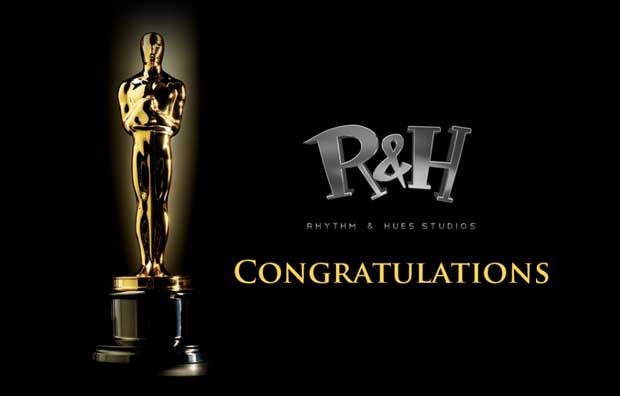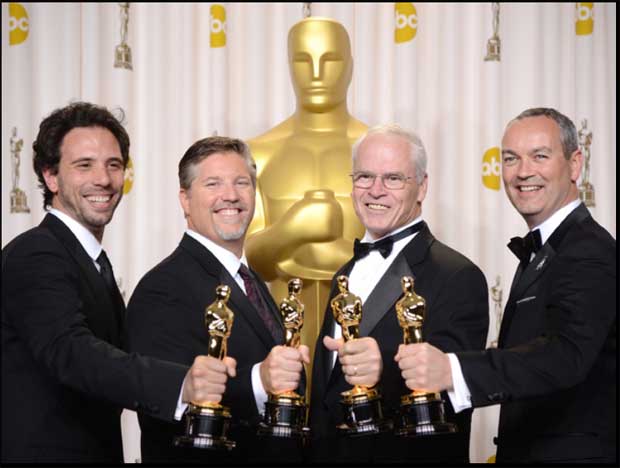
Your comments on winning the Oscar
We feel fortunate and honored to have won the Oscar. Its a proud moment for all of us.
It is a great feeling for all the artists at Rhythm & Hues and a true testament of talent, passion and dedication. It is a great celebration for the entire visual effects industry as well.
Rhythm & Hues has once again proven that given the right encouragement and environment the artists will create Academy Award winning caliber of work, it was possible only because of the support from our Los Angeles Teams and their support.
What was the experience like, working with Ang Lee on the film?
Working with a visionary director like Ang Lee has been a fantastic experience. He is also an awesome human being.
Ang Lee took up the challenge of breathing life into Yann Martel’s beautiful book through his film.
After several tests finally Ang Lee and Fox entrusted Rhythm & Hues to be the lead visual effects house in making this mystical journey a great art extravaganza
Its under the supervision of Vfx Supervisor Bill Westenhofer and animation director Erik De Boer along with Ang Lee’s vision that Life of Pi is breathing.
In the beginning itself, Ang had mentioned that he wanted to make art with us. From there the wonderful journey began.
Ang is a very humble person and creates a humbling effect for everyone around him.
He gave us very specific directions of what he was looking out for which helped us in understanding what was really expected.
One of the examples would be Instead of saying “go get me a sunset,” Ang would say, “give me a pensive sky,” or a “melancholy sky”.
He also gave the artists creative freedom and believed in our ability to get the work done.
When he came down to India for a press conference he personally acknowledged the quality of work done by the Indian artists.
He felt that the work was equivalent to work from anywhere across the globe
During the shoot in Pondicherry, our Indian supervisors also got a chance to go on set and meet Ang and see him in action.
Ang has shown the beauty of India in its purest form and has captured the true spirit and culture of India.
Each and every piece of the film is art.
Has winning the Oscars become a habit for Rhythm & Hues?
At Rhythm & Hues, our focus has always been on the journey rather than the goal. We have always believed in taking care of our employees and creating the highest quality of work and enjoy everyday.

Getting recognition from the Academy and receiving an Oscar gives us great pride and encourages us to do even better.
Specially working on projects like Life Of Pi makes us push our limits and set new benchmarks.
Were all your studios across North America and Asia involved on the feature?
Yes. Life of Pi was a global effort with artists contributing from Los Angeles, Mumbai, Hyderabad, Kuala Lumpur, Vancouver and Taiwan. About 600+ artists worked on it over a period of 3 years.
Almost 40% of the visual effects work on the movie was done out of the Rhythm & Hues studios in Asia.
What were the most challenging sequences and new ground broken with the Visual Effects and CGI on Life of Pi?
Life of Pi presented great Vfx challenges including creating digital oceans, fantastic virtual environments, and realizing incredible lead characters like Richard Parker, the magnificent digital tiger, all in stereo 3D.
The biggest challenge was to create Richard Parker (the Royal Bengal tiger) as the movie was heavily driven by Pi’s interaction with the tiger.
It not only had to look real, but it also had to be made believable to come across as a living, breathing Actor (character). A team went to France to spend some time with the tigers and study their behavior. They collected lots of references from there.
The goal was to ensure that nobody can make out the difference between the real tiger and the cg tiger.
The flying fish sequence was quite challenging as there are tens of thousands of fish flying as it slams and hits the boat, Pi and Richard Parker. The sheer number of fish in the scene alone became one of R&H’s most complicated Massive set-ups ever tackled to date. The simulation had to be run at 120 frames per second and because the fish that to travel such a long distance – from being far away from the boat to flying way past the boat.
Another challenging sequence was the meerkat island as it was a big intertwined island of roots and trees, and thousands of meerkats and water simulations.
You can’t have roots that are low-res or cheats, because of the stereo. We had to create an instancing property for geometry to let us put in hundreds of trees and roots.”
The sequence presented two types of challenges: 1) how to render a huge island made of tangled roots and trees (there was no ground) and how to make the island look believable, and 2) how to best portray the millions of meerkats’ interaction with the ground.
Can we have comments and reactions on winning the Oscar from some of the key members that worked on Life of Pi
From the beginning we realized that its a special project and we all are really proud to be part of the journey. Its been really incredible to see the “Richard Parker” coming to life, that too in stereo.
post awards celebrations of R&H with the Oscar :
This was something which was never done before and required the very best from every department. We are glad that Academy has recognized the efforts and hard work put by all of us.
Its not realistic to expect an Oscar on every movie that you work on, but “Life of Pi” had something magical about it that made us believe that it could be a potential winner.
Additional Comments
Working on Life of Pi was a great learning experience for everyone at Rhythm & Hues , it is a proud moment to be involved in this Academy Award winning film which has such deep rooted ties to India and Taiwan.
Over 300 of Rhythm & Hues digital artists were based in Asia and were involved in all stages of the production, from the initial stages of R&D along with Stereo quality control, Modeling, Pre-lighting, texturing, to Match Moving, Background Preparation / Rotoscopy, Animation, Cloth and fur simulation, Water simulation , Lighting and Final compositing.
For the first time we had our own Supervisors from India leading key sequences in the film both from LA as well as India.
Cloud Computing and visual Effects (CAVE) done in Taiwan helped us finish the project in time. Artist were rendering their shots locally as well as on Cave.
The complete process of transferring work data to CAVE, rendering the same & receiving the rendered output transferred back to the local location was a smooth experience for our artists.
The concept of remote rendering was perfected in the Life of Pi production and all the work done by the artists was delivered seamlessly on account of all the advances in pipeline.
